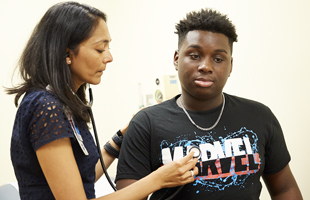Study to Provide a Head-to-Head Comparison of Therapies for Adolescent-Onset Type 2 Diabetes

More than 5,000 people in this country under the age of 20 are diagnosed with type 2 diabetes each year. Medical management doesn’t work as well for adolescents as it does for adults, but bariatric surgery may offer hope. Researchers at Cincinnati Children’s and Children’s Hospital Colorado recently launched a study in adolescents that will provide a head-to-head comparison of the most popular type of bariatric surgery and advanced medical management. The need for such research is critical.
“Type 2 diabetes in youth is different than adult onset: It is more aggressive and progresses faster, and youth develop more severe comorbidities,” says Amy Sanghavi Shah, MD, MS, a pediatric endocrinologist at Cincinnati Children’s who is one of the study’s principal investigators. “This study will help determine whether vertical sleeve gastrectomy is more effective than advanced medical management in promoting glycemic control and reducing co-morbidities in this patient population.”
Part of the inspiration for this work comes from a study that Cincinnati Children’s researchers co-authored called “Five-Year Outcomes of Gastric Bypass in Adolescents as Compared with Adults” ( NEJM, May 30, 2019). The study found that adolescents and adults who had bariatric surgery experienced significant weight loss that was similar in magnitude five years after surgery.
The study also observed that type 2 diabetes went away for most of the study’s adolescent subjects who had surgery. But only a small percentage of those patients had type 2 diabetes in the first place. And most underwent Roux-en-Y gastric bypass, rather than vertical sleeve gastrectomy, which in recent years has become more popular for obese adolescents.
The new study, which is funded by the National Institutes of Health, will enroll 90 patients between the ages of 13 and 19. One group will undergo vertical sleeve gastrectomy, which is approved for adolescents with obesity. The control group will receive advanced medical therapy. “The first-line treatment will be metformin, and if that isn’t effective we can progress to newer agents before trying exogenous insulin,” Shah says. “One option is liraglutide, a glucagon-like peptide-1 receptor agonist that was recently approved for pediatric use. Another option is a class of drugs called SGLT-2 inhibitors, which are approved for use in adults to lower HbA1c. These drugs can be used in combination or separately, depending on patient response.”
In the six-month ramp-up period, all patients will receive guidance to help them make healthy lifestyle changes related to diet and exercise. The study will examine multiple outcomes, with the primary endpoint of helping patients achieve an HbA1c result of less than 6.5% with a lower incidence of comorbidities at one and two years.
“It’s important to find out if optimal medical therapy can compete with bariatric surgery for adolescents with type 2 diabetes,” Shah explains. “The study should also help us better understand the mechanisms underlying metabolic bariatric surgery in youth, which could guide the development of non-surgical treatments targeting these same pathways.”

